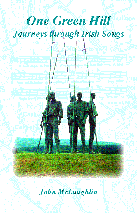But if you feel like singing an Irish song, remember:
The simple solutions suggested in the songs - on the one hand drive the British into
the sea, on the other croppies lie down - are no longer viable. The old songs though
won't simply be abandoned for they are too integral a part of both Catholic and Protestant
history and culture, etched into our being in the cradle and in the cradles of our
ancestors. However by looking at them afresh, in context and appreciating that the
participants on both sides were mere victims of the chance and circumstance of history,
it's my hope, however vain, that both traditions may be able to view the other with
just a little more tolerance and appreciation. (J. McLaughlin)
In the end, I guess, Taigs and Prods like Guinness best instead the Waters
of the Boyne.
Oíche mhaith, T:-)M.
Breathnach, Breandan. Folk Music and Dances of Ireland.
Ossian, Cork, 1996, ISBN 1-900-428-652, Paperback, 152pp.
Carson, Ciaran. Irish Traditional Music.
Appletree, Belfast, 198, ISBN 0-86281-168-6, Paperback, 72pp.
Doyle, Danny & Terence Folan. The Gold Sun of Irish Freedom - 1798 in Song and Story.
Mercier, Dublin, 1998, ISBN 1-85635-208-0, Paperback, 202pp.
McLaughlin, John. One Green Hill - Journeys through Irish Songs.
Beyond the Pale, Belfast, 2003, ISBN 1-900960-21-4, Hardcover, 233pp, £14,90.
Moylan, Terry. The Age of Revolution in the Irish Song Tradition - 1776 to 1815.
Lilliput, Dublin, 2000, ISBN 1-901866-49-1, Paperback, 168pp.
O hAllmhurain, Gearoid. A Pocket History of Irish Traditional Music.
O'Brien, Dublin, 1998, ISBN 0-86278-555-3, Paperback, 160pp.
Vallely, Fintan (ed.). The Companion to Irish Traditional Music.
Cork University Press, Cork, 1999, ISBN 1-85918-148-1, Hardcover, 478pp.
Wallis, Geoff & Sue Wilson. The Rough Guide to Irish Music.
Rough Guides, London, 1999, ISBN 1-85828-642-5, Paperback, 599pp.
Zimmermann, Georges Denis. Songs of Irish Rebellion - Irish Political Street Ballads and Rebel Songs, 1780-1900.
Four Courts, Dublin, 2002, ISBN 1-85182-629-7, Paperback, 342pp.
More Things Irish:
FW#19,
FW#20,
FW#22,
FW#24
T:-)M's Night Shift, FW#26
Back to the content of FolkWorld Features
To the content of FolkWorld No. 27
© The Mollis - Editors
of FolkWorld; Published 02/2004
All material published in FolkWorld is © The
Author via FolkWorld. Storage for private use is allowed and welcome. Reviews
and extracts of up to 200 words may be freely quoted and reproduced, if source
and author are acknowledged. For any other reproduction please ask the Editors
for permission. Although any external links from FolkWorld are chosen with greatest
care, FolkWorld and its editors do not take any responsibility for the content
of the linked external websites.
FolkWorld - Home of European Music

Layout & Idea of FolkWorld © The
Mollis - Editors of FolkWorld
 "When we study the semi-political songs of the Irish peasantry, we should bear in mind
the magical power attributed to words in traditional societies, the potency of
language for inflicting harm or obtaining what is most desired. The belief in the
possibility to change the world by songs and speeches is perhaps one of the keys
to the understanding of Irish political and patriotic literature." (G.D. Zimmermann)
"When we study the semi-political songs of the Irish peasantry, we should bear in mind
the magical power attributed to words in traditional societies, the potency of
language for inflicting harm or obtaining what is most desired. The belief in the
possibility to change the world by songs and speeches is perhaps one of the keys
to the understanding of Irish political and patriotic literature." (G.D. Zimmermann)
 history of Ireland, i.e. those songs which we usually call rebel songs and,
equally, their counterparts in the pro-British tradition.
history of Ireland, i.e. those songs which we usually call rebel songs and,
equally, their counterparts in the pro-British tradition.





 fame (-> FW#6) attributing "The Foggy Dew"
(-> FW#13, FW#20) to
Padraic Pearse
who actually dies in this song (-> FW#26).
Let's hear John about it:
fame (-> FW#6) attributing "The Foggy Dew"
(-> FW#13, FW#20) to
Padraic Pearse
who actually dies in this song (-> FW#26).
Let's hear John about it:
 Let Bacchus' sons be not dismayed but join me each jovial blade,
which was adopted by General Custer as the regimental march of the 7th US Cavalry.
Today there is also a town called Garryowen within the former Little Bighorn battlefield.
Let Bacchus' sons be not dismayed but join me each jovial blade,
which was adopted by General Custer as the regimental march of the 7th US Cavalry.
Today there is also a town called Garryowen within the former Little Bighorn battlefield.
